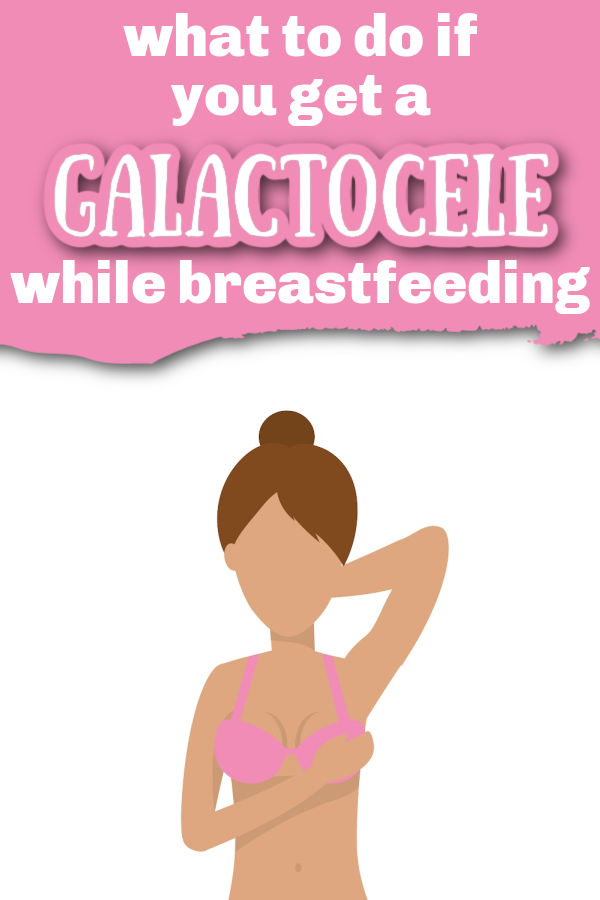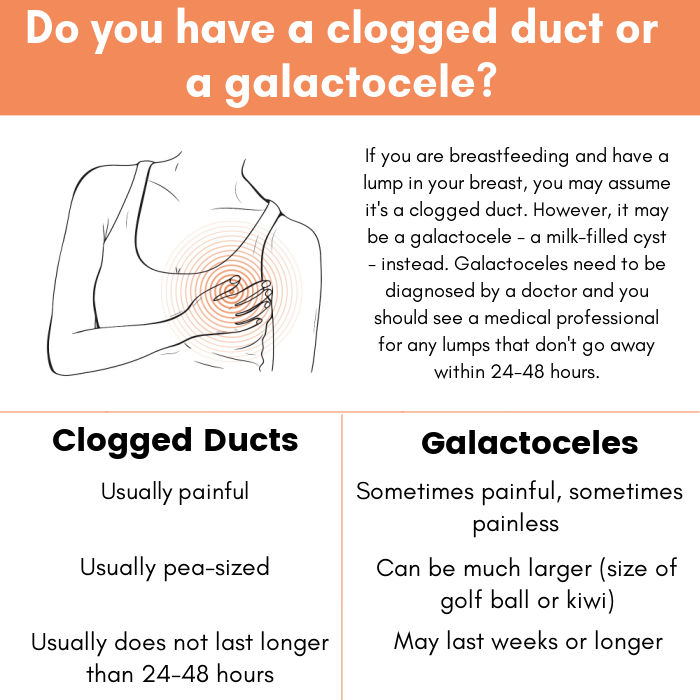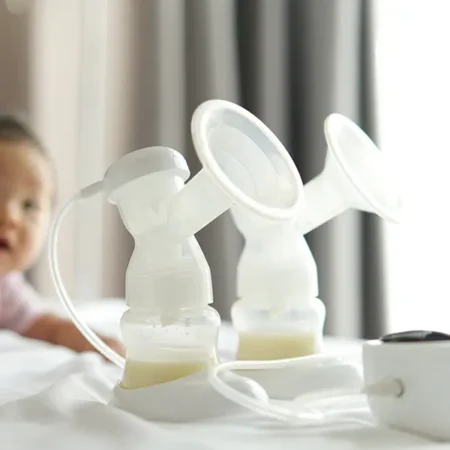Most people assume that a lump in their breast when they are breastfeeding is a clogged duct. While this is often the case, moveable lumps in your breast may also be galactoceles – cysts filled with breast milk. Here is what you need to know about galactoceles.

This post may contain affiliate links, which means that if you click through and make a purchase, I’ll be compensated at no additional cost to you. I only recommend products I love! More info here.
What is a galactocele?
A galactocele is a cyst in the breast that is filled with breast milk.
They occur (fairly rarely) in people who are pregnant, lactating, or have recently been lactating.
How can I tell if I have one? Galactocele vs plugged duct
If you are lactating and you notice a smooth, moveable lump in your breast, you might have a galactocele.
They are sometimes mistaken for clogged ducts or for breast cancer (since both of these also have lumps as the first symptom).

The major differences between clogged ducts and galactoceles include:
- Pain. Clogged ducts usually hurt quite a bit – it’s a sharp pain, especially when the area is touched. On the other hand, galactoceles may or may not be painful. The pain, if there is any, is caused by the surrounding tissue being stretched.
- Size. Galactoceles are often much larger; they can be from 1 to 6 cm in diameter, while clogged ducts are usually pea-sized. Therefore, a golf ball sized lump in your breast is far more likely to be a galactocele than a clogged milk duct. Additionally, galactoceles often change size (sometimes filling up, sometimes getting smaller).
- Duration. Clogged ducts are usually cleared with a day or two, or they progress to mastitis. Galactoceles can last weeks.
Galactoceles have to be diagnosed by a doctor.
Because galactoceles and breast cancer both present with smooth and moveable lumps, doctors will generally refer people who have them for a breast cancer screening. In most cases, you will get an ultrasound and a biopsy to evaluate the lump; however, sometimes a mammogram is the first step.
One important thing to note is that galactoceles are not dangerous and have no relationship to breast cancer. The main issue with them (and of course it’s not a small one) is your discomfort.
That being said, any lump in your breast that doesn’t resolve within 24-48 hours should be evaluated by a medical professional to ensure it’s not something serious.
How are they treated? Will galactoceles go away on their own?
If they aren’t painful, the standard treatment for a galactocole is the same as it is for a cyst: just leaving them alone.
If they are painful, they can be drained via fine needle aspiration (though unfortunately, they sometimes fill up again).
Most of the time, your body will reabsorb an untreated galactocele when you are done breastfeeding. If for whatever reason it doesn’t, the milk duct can be removed surgically.
Ibuprofen and warm showers can help treat the pain associated with the them.
Can galactoceles turn into cancer?
No. They are cysts filled with breast milk and cannot turn into cancer.
They also do not increase the risk of developing breast cancer.
Can you have a galactocele in your armpit?
It’s possible for you to have breast tissue in your underarm, and so you can get galactoceles there.
Is there any way that I can prevent it from coming back?
Unfortunately, there is no definitive way to do this without surgery. If the milk is aspirated, it can fill right back up again.
Here are a few things of your options:
- Weaning from the affected breast (and continuing to pump from the breast without the galactocele).
- Surgical removal of the milk duct (before or after weaning from breastfeeding).
- Several people stated that their galactocele was significantly reduced when they got the flu and became dehydrated (this obviously isn’t something I would recommend, but you can see if decreasing fluid intake a bit – not to the degree that you become dehydrated – helps keep the size under control)
- Taking a lecithin supplement to decrease the stickiness of your milk.
(Legendairy Milk reached out and gave me a discount code for their sunflower lecithin. Take 15% off with the code 15EPUMP!)
I would encourage anyone who thinks that they may have a galactocele to read these first-hand accounts from people who had one, along with this scientific explanation of how they are diagnosed.
Have you had a galactocele? It would be great if you could comment and tell us about your experience!
References- Moose & Doc Breast Cancer. “Galactocele of the Breast.” https://breast-cancer.ca/miscellaneous-breast-lesions/galactocele.htm
- American Journal of Surgery. “Galactocele of the Breast.” https://www.americanjournalofsurgery.com/article/0002-9610(64)90352-6/abstract














